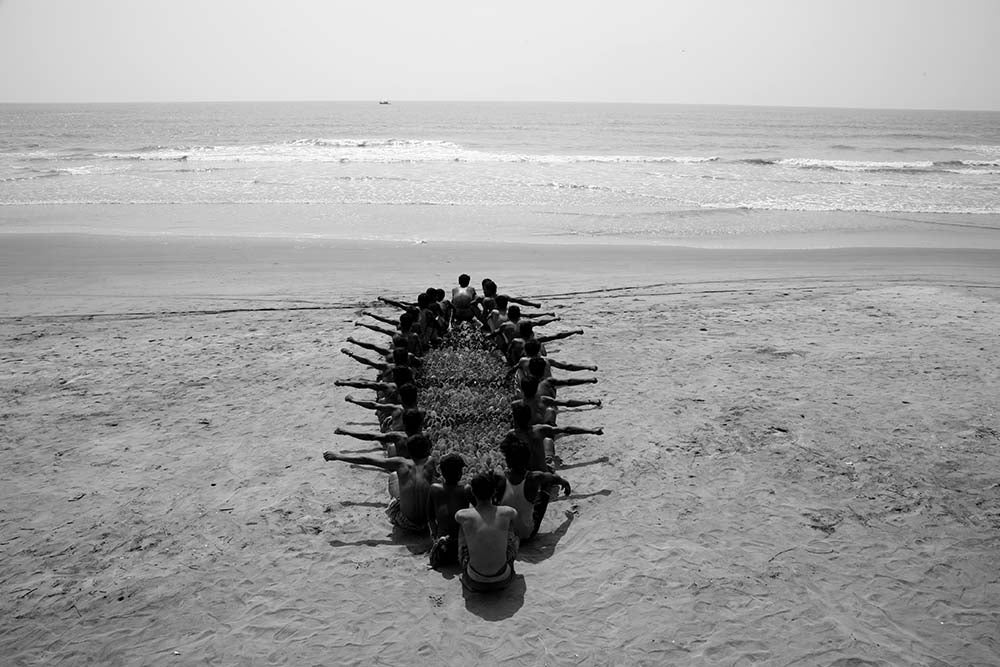Prints

Fishermen and the Ocean
Subodh Kerkar got connected with the lives of fishermen, since he used to practice medicine in their village. He has got an intimate knowledge of fishermen's lives. He realized that their lives are inseparable from the ocean. The ocean is not just the provider of fish; their existence is marinated in the ocean. Through his works he has tried to present this idea of inseparability of the fishermen and the sea. The works also celebrates the role the ocean plays in shaping civilizations.

150 Natals
Indo-Portuguese houses are an important part of Goan cultural ethos. Most houses were constructed in the second half of the 19th century. Most Catholics paint the exterior of their houses annually before Christmas (Natal in Portuguese). There is a large dilapidated house, belonging to the Gomes family, which is over 150 years old. This house must have received at least 150 coats of lime. The first 30 years or so it was painted white, followed by about 40 layers of lime mixed with indigo. The following generations decided to use red oxide. For the last fifty years the house has received coats of yellow ochre. In this work, Subodh Kerkar used cut-out pieces of the wall that reveal the coloured history of the house through carvings. ‘150 Natals’ is a mnemonic device, evocative of a hundred and fifty Christmas
celebrations by the Gomes family.

Goa Nostalgia
By C. S. Kerkar
These works by C. S. Kerkar, father of our founder, Subodh Kerkar, were painted between 1950 and 2004. Majority of his works are connected with fishing scenes and fish markets, which formed a major part of Goa’s cultural ethos. There are also paintings depicting scenes of other village activities. One of the paintings shows a man bargaining with a fisherwoman. He is making a sign of two with his fingers. In 1965, when the work was created, the two fingers meant Rs. 2/-. Over the years, the price of the fish has risen from Rs. 2/- to Rs. 2,000/-. Mr. Kerkar’s works are a great visual record of Goan life of the bygone days.


Goan Houses
The Portuguese conquered Goa in 1510. Their objective was to control the spice trade and spread Christianity. They arrived with drawings for churches, representative of the architectural styles prevalent in Europe during that period such as Manueline, Renaissance, Mannerist, Baroque, Gothic, etc.The local masons interpreted these drawings and adapted them to suit the locally available construction materials and weather conditions.Old Goa, which is called the Rome of the East, became a laboratory of architectural experiments. A couple of centuries later, the descendants of these masons started constructing houses, which are described by many as ‘Portuguese Houses’. These houses indicate a rich assimilation of many European styles, yet they embody a distinctly indigenous architectural language. The Goan houses exhibit distinct features in their window designs, verandahs, porches (Balcao), compound walls, gate posts, columns, railings, pilasters, cornices and floorings. Each house has individual features selected by the owner yet a shared architectural aesthetic binds them together.Goan houses have a huge role to play in Goa’s cultural ethos. Her houses, churches and chapels are important hallmarks of the unique ‘Goa experience’.Goans are very proud of their houses and look after them with great care and affection. Each house can be described as a living archive of Goa’s histories. The owner, often displays a ‘NOT FOR SALE’ signage to discourage visitors who perhaps dream of buying a Goan house!

Drawings
Subodh Kerkar loves to draw. There are many drawings that are even created at 36,000 feet high in the sky during his flight travels.

Ganesha
Ganesh Chaturthi, is one of the most celebrated Hindu festivals in Goa and Maharashtra. Households worship Lord Ganesha for prosperity, good fortune, wisdom and to build the courage to conquer one's fears and overcome the obstacles in life. The artist has portrayed Lord Ganesha in various forms to celebrate his divine powers and childlike personality.